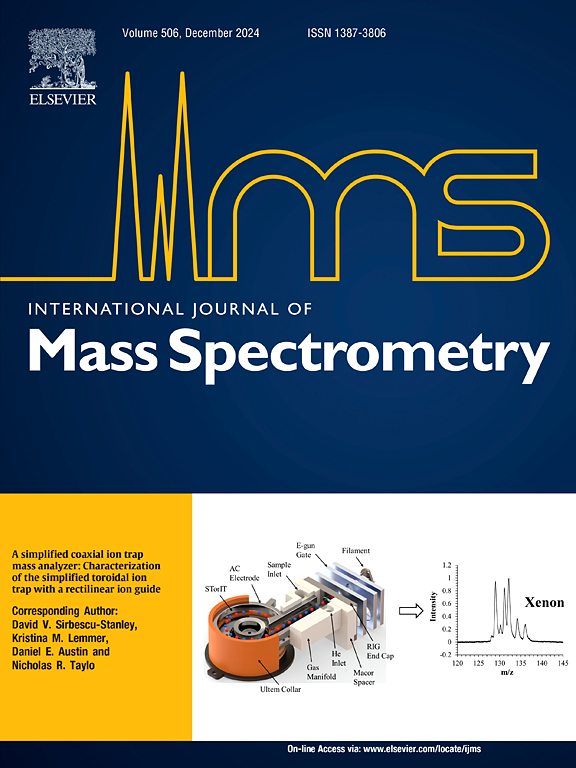Gas phase proton affinities of proline-containing peptides. 2: ProCys, ProMet, ProSer, ProThr, ProTyr, ProPhe, and ProTrp
IF 1.7
3区 化学
Q3 PHYSICS, ATOMIC, MOLECULAR & CHEMICAL
引用次数: 0
Abstract
The gas-phase proton affinities (PA) for a series of proline-containing dipeptides have been measured in an ESI triple quadrupole instrument using the extended kinetic method (EKM). Proton affinities of ProCys (1), ProMet (2), ProSer (3), ProThr (4), ProTyr (5), ProPhe (6), and ProTrp (7) were determined to be 966.9 ± 5.3, 987.9 ± 10.4, 978.4 ± 6.1, 978.3 ± 6.1, 993.9 ± 11.2, 985.1 ± 10.7, and 998.7 ± 7.6 kJ/mol, respectively. Predictions for the proton affinities for 1–7 were also obtained through isodesmic calculations at the B3LYP/6–311++G(d,p)//B3LYP/6-31+G(d) level of theory. As with a previous study on the proton affinities of ProXxx dipeptides with aliphatic side chains (Cardwell et al., Int. J. Mass Spectrom. 2025, 507, 117352) the agreement between theory and experiment is mixed. For the two dipeptides with sulfur in the side chain we find excellent agreement between the EKM and calculated proton affinities. For the three dipeptides with hydroxyl groups in the side chain, the experimental values are between 7.2 and 13.2 kJ/mol larger than the computed proton affinities. Additional single point energy calculations on 3–5 with B3LYP/6–311++G(2df,2p) basis sets give predicted proton affinities that are somewhat smaller than those predicted with the B3LYP/6–311++G9d,p) basis set. MP2/6-311z++G(2df,2p) single point energy calculations on 3 and 4 give calculated proton affinities within 1 kJ/mol of the B3LYP/6–311++G(d,p) values. It appears that the EKM values for 3–5 are systematically too high, possible o to the extrapolation required to obtain the isothermal point in the EKM workup due to the large protonation entropies of the dipeptides. This result is also seen to a lesser extent for ProPhe and ProTrp in which the EKM proton affinities are 5–6 kJ/mol larger than the calculated values. As with the aliphatic ProXxx dipeptides from our previous study, we recommend using the calculated proton affinities for 1–7 with the experimental proton affinities as upper limits.

含脯氨酸肽的气相质子亲和。2: ProCys, ProMet, ProSer, ProThr, proyr, prohe, prop
采用扩展动力学方法(EKM)在ESI三重四极杆仪器上测定了一系列脯氨酸二肽的气相质子亲和。ProCys(1)、ProMet(2)、ProSer(3)、ProThr(4)、ProTyr(5)、prohe(6)和propro(7)的质子亲和分别为966.9±5.3、987.9±10.4、978.4±6.1、978.3±6.1、993.9±11.2、985.1±10.7和998.7±7.6 kJ/mol。通过在B3LYP/ 6-311 ++G(d,p)//B3LYP/6-31+G(d)理论水平上的等重力计算,预测了1-7的质子亲和。与先前对具有脂肪侧链的ProXxx二肽的质子亲和性的研究一样(Cardwell et al., Int。[j] .质谱学报,2015,51(1):557 - 557。对于侧链中含硫的两种二肽,我们发现EKM与计算的质子亲和关系非常吻合。对于侧链上有羟基的三种二肽,实验值比计算的质子亲和值大7.2 ~ 13.2 kJ/mol。用B3LYP/ 6-311 ++G(2df,2p)基集在3-5上进行额外的单点能量计算,得到的预测质子亲和力比用B3LYP/ 6-311 ++G9d,p)基集预测的要小一些。MP2/6-311z++G(2df,2p)对3和4的单点能量计算得出的质子亲和值与B3LYP/ 6-311 ++G(d,p)值相差1 kJ/mol。3-5的EKM值似乎系统地太高了,这可能是由于二肽的大质子化熵而导致在EKM工作中获得等温点所需的外推。prohe和prop的EKM质子亲和比计算值大5-6 kJ/mol,这一结果在较小程度上也可见。与我们之前研究的脂肪族ProXxx二肽一样,我们建议使用1-7的计算质子亲和和实验质子亲和作为上限。
本文章由计算机程序翻译,如有差异,请以英文原文为准。
求助全文
约1分钟内获得全文
求助全文
来源期刊
CiteScore
3.60
自引率
5.60%
发文量
145
审稿时长
71 days
期刊介绍:
The journal invites papers that advance the field of mass spectrometry by exploring fundamental aspects of ion processes using both the experimental and theoretical approaches, developing new instrumentation and experimental strategies for chemical analysis using mass spectrometry, developing new computational strategies for data interpretation and integration, reporting new applications of mass spectrometry and hyphenated techniques in biology, chemistry, geology, and physics.
Papers, in which standard mass spectrometry techniques are used for analysis will not be considered.
IJMS publishes full-length articles, short communications, reviews, and feature articles including young scientist features.

 求助内容:
求助内容: 应助结果提醒方式:
应助结果提醒方式:


